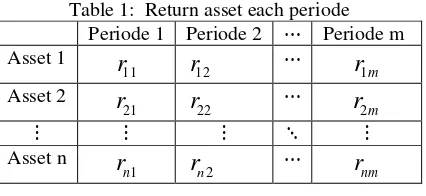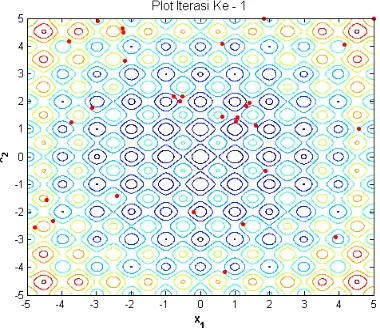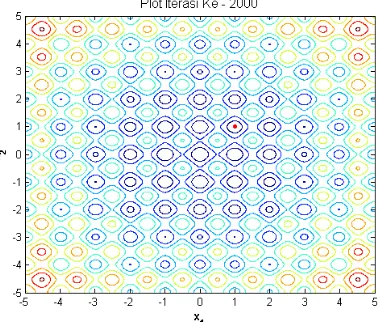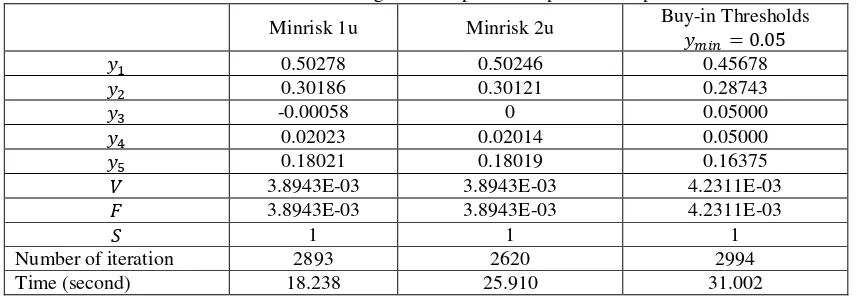Vol.1, No.1, Juli 2017, Hal. 370-377
p-ISSN: 2580-4596; e-ISSN: 2580-460X Halaman | 370
Portfolio Optimization With Buy-in Thresholds Constraint
Using Simulated Annealing Algorithm
Indana Lazulfa1, Pujo Hari Saputro2
1,2 Department of Informatics Engineering, Hasyim Asy’ari University Jombang
[email protected], [email protected]2
Info Artikel ABSTRACT
Riwayat Artikel: Diterima: 15 Mei 2017 Direvisi: 1 Juni 2017 Diterbitkan: 31 Juli 2017
Portfolio optimization is a solution for investors to get the return as much as possible and also to minimize risk as small as possible. In this research, we use risk measures for portfolio optimization, namely mean-variance model. For single objective portfolio optimization problem, especially minimizing risk of portfolio, we used mean-variance as risk measure with constraint such as buy-in thresholds. Buy-buy-in thresholds set a lower limit on all assets that are part of portfolio. All this portfolio optimization problems will be solved by simulated annealing algorithm. The performance of the tested metaheuristics was good enough to solve portfolio optimization.
Kata Kunci:
Portfolio optimization Mean-variance Single objective Buy-in threshold
Simulated annealing algorithm Copyright © 2017 SI MaNIs.
All rights reserved.
Corresponding Author:
Indana Lazulfa,
Departement of Informatics Engineering,
Hasyim Asy’ari University Jombang,
Jl. Irian Jaya No. 55 Jombang, Jawa Timur, Indonesia 61471 Email: [email protected]
1. INTRODUCTION
A portfolio is a set/group of financial assets such as stocks, bonds and cash equivalents, as well as their funds counterparts, including mutual, exchange-traded and closed funds. Portfolios are held directly by investors and/or managed by financial professionals. Prudence suggests that investors should construct an investment portfolio in accordance with risk tolerance and investing objectives (return).
Portfolio optimization is an effort made by investors to get the maximum return and the smallest risk. But in fact, the desire to get a high return must be go along with a high risk. We can say that if we want high return, we also get high risk.
The most important things in portfolio optimization problems are minimizing risk and maximize return. Models of optimization are often used to solve portfolio optimization problem is the mean-variance model. For first time, it was developed by Harry Markowitz in 1952. This model is based on mean and variance approach.
Markowitz mean-variance model of portfolio selection is one of the best models in finance. In its basic form, this model requires to determine the composition of a portfolio of assets which minimizes risk while achieving a predetermined level of expected return. From a practical point of view, however, the Markowitz model may often be considered too basic, because it ignores many of constraints faced by real-world investors : trading limitations, size of the portfolio, transaction fee, etc (see e.g. [1] for detail).
small proportion.
The classical mean-variance framework relies on the perfect knowledge of the expected returns of the assets and the variance-covariance matrix [2]. However, these returns are unobservable and unknown. In this paper, the method used to solve portfolio optimization problem is simulated annealing (SA) algorithm. Simulated Annealing (SA) is a random-search technique which exploits an analogy between the way in which a metal cools and freezes into a minimum energy crystalline structure (the annealing process) and the search for a minimum in a more general system. SA was developed in 1983 to deal with highly nonlinear problems. SA approaches the global maximization problem similarly to using a bouncing ball that can bounce over mountains from valey to valley [3]. It begins at a high "temperature" which enables the ball to make very high bounces, which enables it to bounce over any mountain to access any valley, given enough bounces. As the temperature declines the ball cannot bounce so high, and it can also settle to become trapped in relatively
small ranges of valleys. A generating distribution generates possible valleys or states to be explored. An acceptance distribution is also defined, which depends on the difference between the function value of the present generated valley to be explored and the last saved lowest valley. The acceptance distribution decides probabilistically whether to stay in a new lower valley or to bounce out of it. All the generating and acceptance distributions depend on the temperature.
There are some previous study of portfolio optimization in single objective with mean-variance model and two constraints (buy in thresholds and roundlot). It has been done by Biggs – Kane using direct method [4]. It also has been done by Jobs – Mitra with adding cardinality constraints [5]. Chang ‘s research is about portfolio optimization with different measure of risk : mean – variance and MAD using genetic algorithm (GA). Chang do the computational with C++ software. Its result shows that GA method is quite effective for solving portfolio optimization problems [6].
The remainder of this paper is organized in four sections. Section 2 introduces the portfolio selection model that we want to solve. Besides, there is basic structure of simulated annealing algorithms and contains a detailed description of simulated annealing algorithm. In Section 3, we show some result of simulation like the tested metaheuristic algorithm, some details of the implementation and computational experiments. The last section, Section 4 contains a summary of our work and some conclusions.
2. PORTFOLIO OPTIMIZATION
2.1.
The Markowitz mean-variance model
Prosiding SI MaNIs (Seminar Nasional Integrasi Matematika dan Nilai Islami) Vol.1, No.1, Juli 2017:
370-𝑄 is variance-covariance matrix. Minimizing
y
TQ
y
equivalent with minimizing risk so its can be level risk of portfolio [9].Table 1: Return asset each periode Periode 1 Periode 2 ⋯ Periode m subsection there are some constraints like Minrisk and Maxret. Minrisk is constraints that minimizing risk and Maxret is constraints that maximizing return.
Minrisk 0
Min 𝑉 = 𝑦𝑇𝑄𝑦 S.t. 𝑒𝑇𝑦 = 1 Minrisk 0 can be solved by Lagrange multiplier method .
Min 𝐿(𝑦, 𝜔) = 𝑦𝑇𝑄𝑦 + 𝜔(1 − 𝑒𝑇𝑦)
In order to achieve minimum conditions, it must follow the first order condition (FOC) 𝜕𝐿 𝜕𝒚 = 0⁄ dan
𝜕𝐿 𝜕𝝎 = 0⁄ . Minrisk 0 problem with constraint can be changed into unconstrained problem by adding penalty function
Min 𝐹(𝑦) = 𝑦𝑇𝑄𝑦 + 𝜌(𝑒𝑇𝑦 − 1)2 where 𝜌 positive and large penalty constant.
Minrisk 1
If investors wants to get some return from their portfolio, then we can adding return target 𝑅𝑝 to constraints.
Min 𝑉 = 𝑦𝑇𝑄𝑦
S.t. 𝑟̅𝑇𝑦 = 𝑅𝑝 ; 𝑒𝑇𝑦 = 1
As minrisk 0, misnrisk 1 also can be changed into unconstrained problem by adding penalty constant.
Min 𝐹(𝑦) = 𝑦𝑇𝑄𝑦 + 𝜌 (𝑟̅𝑇𝑦 𝑅𝑝 − 1)
2
+ 𝜌(𝑒𝑇𝑦 − 1)2
Minrisk 2
In Minrisk 1 and Minrisk 0, there is a possibility that the proportions of shares are negative. It means there is possibility of investors do the short selling shares or assets. Short selling is the sale of a security/asset that is not owned by the seller, or that the seller has borrowed [10]. Short selling is motivated by the belief
the same security or a related one. Since the risk of loss on a short sale is theoritically infinite, short selling should only be used by experienced traders who are familiar with its risks (see [10] for details). In order to avoid risk, we assume this constraints doesn’t contain short selling. We need additional constraints
𝑦𝑖= 𝑥𝑖2 and 𝑦𝑖≥ 0, 𝑖 = 1,2, … , 𝑛.
An investor will avoid investing in an asset or stock with small proportion. That is because they have to pay the transaction fee, etc but the earned profit is too small. So for asset with small proportion will be ignored or not purchased. So they will take asset that proportion is larger than lower limit 𝑦𝑚𝑖𝑛.
𝑦𝑖= 0 𝑜𝑟 𝑦𝑖≥ 𝑦𝑚𝑖𝑛
2.3. Simulated Annealing (SA) Algorithm
There are many optimization methods for solve optimization problems. Usually the method used is a deterministic method such as Newton Method. However, not all optimization problems can be solve by gradient technique because in many optimization problems whose objective functions are not linear/non linear, are not continuous and have many minimum and maximum points. Therefore, metaheuristic methods show the solution of this optimization problem as non-gradient method. Detailed discussions of simulated annealing can be found in van Laarhoven and Aarts [11], Aarts and Lenstra [12] or in the survey by Pirlot [13]. Here we only give a very brief presentation of the method.
SA is one of the neighborhood search methods that allows inferior solution. This method is a kind of heuristic algorithm. SA is one type of global optimization technique based on natural phenomena namely physic process of annealing (metal cooling). SA is a generic name for a class of optimization heuristics that perform a stochastic neighborhood search of the solution space. The major advantage of SA over classical local search methods is its ability to avoid getting trapped in local minima while searching for a global minimum. The underlying idea of the heuristic arises from analogy with certain thermodynamical processes (cooling of melted solid). Step of this algorithm can be seen at [1].
Prosiding SI MaNIs (Seminar Nasional Integrasi Matematika dan Nilai Islami) Vol.1, No.1, Juli 2017:
Figure 1. SA Algorithm for optimization
3. RESULTS AND ANALYSIS 3.1. Test Function
Before we apply the SA to portfolio optimization, we will use benchmark function to test heuristic algorithm. If we can get the minimum point of those function, then algorithm can be used in optimization problem. One of benchmark function is rastrigin function.
𝑓(𝒙) = 10𝑑 + ∑[𝑥𝑖2− 10 cos(2𝜋𝑥𝑖)] 𝑑
𝑖=1
SA algorithm will find minimum point of rastrigin function in every iteration. At first iteration, position of the state is seen spread throughout the domain/area of the function. Then the state starts moving to search the minimum value of rastrigine function. As the increase of iteration number, they begin to gather in one point that is thought to be a minimum point. Until 2000 iteration, the points stop moving and finding the minimum value of the rastrigine function.
Figure 2. Finding minimum value in 1st iteration while iter < itermax & found == false
iterasi ke- k:=0 while 𝑘 < 𝐸
tetapkan neighbor state j.
𝛿 = 𝑓(𝑗) − 𝑓(𝑖)
if 𝛿 < 0 then 𝑖 = 𝑗
else if rand ( ) <exp (−𝛿
𝑇)then 𝑖 = 𝑗 end(if)
𝑘 = 𝑘 + 1
end(while)
𝑇 = 𝑟 ∗ 𝑇
Figure 3. Finding minimum value in 100th iteration
Figure 4. Finding minimum value in 2000th iteration
3.2. SA Implementation In Portfolio Optimization
Given a historical data return of 5 assets over 10 periods, as follows in Table 2. Return target 𝑅𝑝=
0.0112.
Table 2 : Historical data return 5 assets over 10 periods
Return period Mean
return
1 2 3 4 5 6 7 8 9 10
Asset 1
0.012 0.013 0.014 0.015 0.011 0.012 0.011 0.01 0.01 0.011 0.0119
Asset 2
0.013 0.01 0.008 0.009 0.014 0.013 0.012 0.011 0.012 0.011 0.0113
Asset 3
0.009 0.011 0.01 0.011 0.011 0.013 0.012 0.011 0.01 0.011 0.0109
Asset 4
0.011 0.011 0.012 0.013 0.012 0.012 0.011 0.01 0.011 0.012 0.0115
Asset 5
0.008 0.0075 0.0065 0.0075 0.008 0.009 0.01 0.011 0.011 0.012 0.00905
Prosiding SI MaNIs (Seminar Nasional Integrasi Matematika dan Nilai Islami) Vol.1, No.1, Juli 2017: 370-limit to 0. So we can say that SA algorithm can solve portfolio optimization problem with several constraint like Minrisk 0, Minrisk 1, Minrisk 2 and buy-in thresholds.
Table 3 : Result of SA algorithm in portfolio optimization problem
Minrisk 1u Minrisk 2u Buy-in Thresholds
𝑦𝑚𝑖𝑛= 0.05
𝑦1 0.50278 0.50246 0.45678
𝑦2 0.30186 0.30121 0.28743
𝑦3 -0.00058 0 0.05000
𝑦4 0.02023 0.02014 0.05000
𝑦5 0.18021 0.18019 0.16375
𝑉 3.8943E-03 3.8943E-03 4.2311E-03
𝐹 3.8943E-03 3.8943E-03 4.2311E-03
𝑆 1 1 1
Number of iteration 2893 2620 2994
Time (second) 18.238 25.910 31.002
4. CONCLUSION
In this paper, we have formulated a heuristic Simulated Annealing to solve portfolio optimization problem. Portfolio optimization is a solution for investors to get the return as large as possible and make the risk as small as possible. For single objective portfolio optimization problem, especially minimizing risk of portfolio, will be used mean – variance as risk measure with constraint buy-in threshold.
Based on result in Section 3, SA algorithm is fairly effective method for solving portfolio optimization problems especially for single objective problems. SA shows good results in searching minimum value for global solutions. The results of single objective cases has provided by SA is near optimal solution. SA also give us fast computing process and robust/near–good result. We get proportion of each assets
(𝑦1, 𝑦2, 𝑦3, 𝑦4, 𝑦5 ) that can be reduced risk as small as possible (𝑉 → 0).
ACKNOWLEDGEMENTS
SA provides a powerful way to help you finding a global minimum. SA provides a robust solution or feasible solution that near optimal solution. But robust solution has been enough for engineering problem or other optimization problem. Parameters used in SA still use user’s feeling or trial and error. So for anyone who will research with SA algorithm, we recommend to study many references to determine good parameter in SA algorithm. Further studies can focus on the sensitivity and parameter studies and their possibility for convergence rate of the algorithm.
REFERENCES
[1] Crama, Y., Schyns, M. 2001. Simulated Annealing for Complex Portfolio Selection Problems. University of University of Liége, Bd. Du Rectorat 7, Liége, Belgium.
[2] Bonami, P., Lejeune, M.A. 2009. An Exact Solution Approach for Portfolio Optimization Problems Under Stochastic and Integer Constraints. Journal Operation Research, 57, 650-670.
[3] Ingber, L. 1993. Simulated Annealing : Practice Versus Theory. Mathematical Computation Modelling 18. 11. 29-57.
[4] Biggs, M.B. & Kane, S.J. 2007. A Global Optimization in Portfolio Selection. Journal Management Science, 6, 329–345.
[5] Jobst, N.J., Horniman, M.D., Lucas, C.A. & Mitra, G. 2001. Computational Aspects of Alternative Portfolio Selection Models in The Presence of Discrete Asset Choice Constraints. Quantitative Finance. Vol 1. 1–13.
[6] Chang, T.J., Yang, S.C. & Chang, K.J. 2009. Portfolio Optimization Problems in Different Risk Measures Using Genetic Algorithm. Expert System with Application, 36, 10529–10537.
York – London.
[9] Bartholomew-Biggs, M. 2005. Nonlinear Optimization with Financial Applications. Kluwer Academic Publisher.
[10]Hull, J.C. 2012. Options, Futures, and Other Derivatives Eighth Edition. Pearson, Prentice Hall : United States of America.
[11]Van Laarhoven P.J.M., Aarts E.H.. 1988. Simulated Annealing : Theory and Applications. Kluwer Academic Publishers.
[12]Aarts, E., Lenstra, J.K.. 1997. Local Search in Combinatorial Optimization. John Wiley & Sons : New York. [13]Pirlot M. 1992. General Local Search Heuristics in Combinatorial Optimization : A Tutorial. Belgian Journal of
Operations Research, Statistics and Computer Science 32. Pp 7–68.



